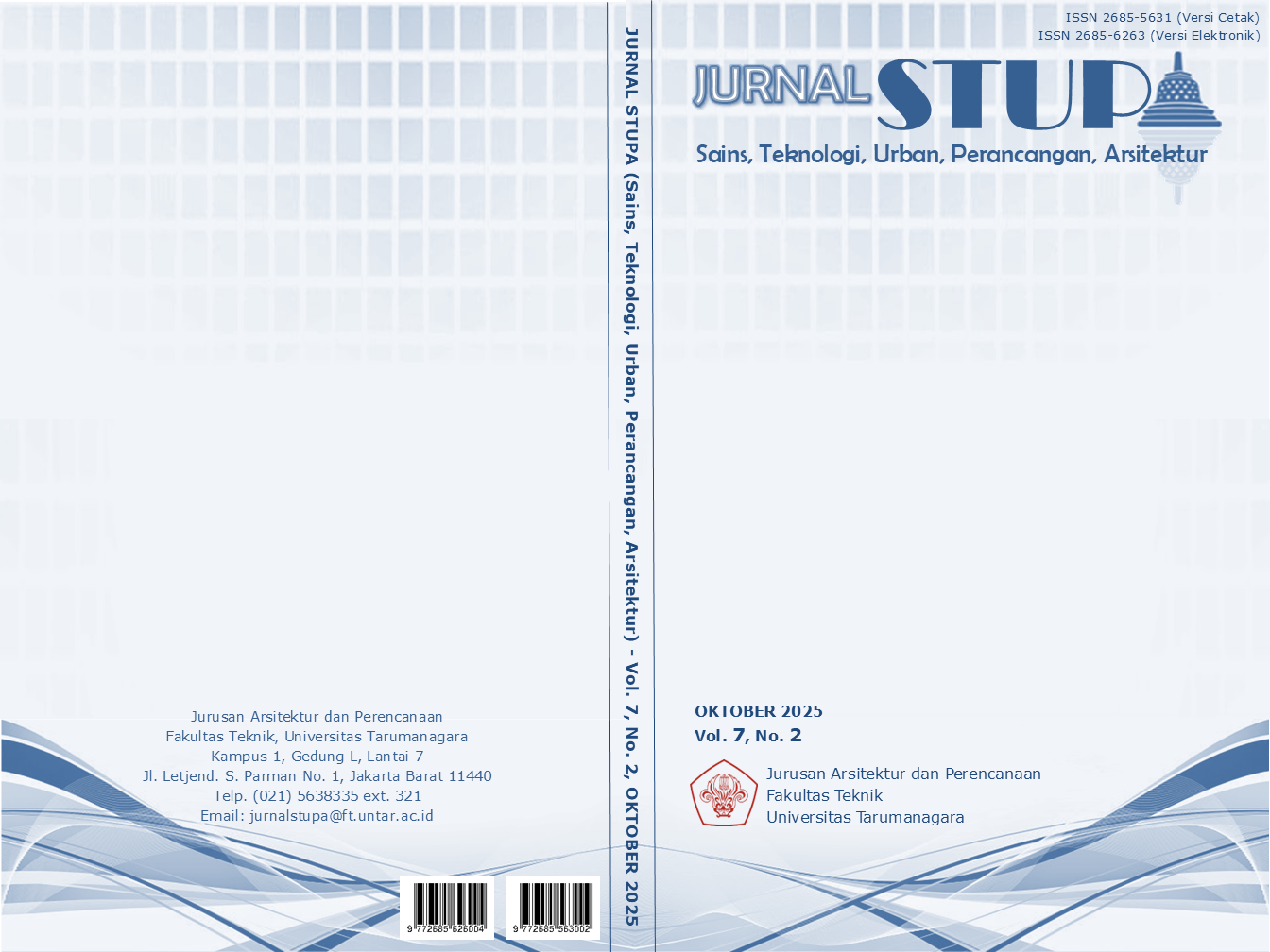TRANSFORMASI SOSIAL DALAM PARADIGMA TENGGELAM MELALUI RUANG PEMBERDAYAAN KOMUNITAS NELAYAN DI PESISIR MUARA ANGKE
Main Article Content
Abstract
The city of Jakarta is gradually experiencing geographical and ecological transformation due to land subsidence, sea level rise, and the continuous imbalance of urban development. One of the most significantly affected areas is Muara Angke, a coastal zone in North Jakarta inhabited by fishing communities, yet burdened by dense warehousing, piles of domestic waste, and the pressure of urbanization. Rather than preserving land that is constantly at risk of submersion, this project responds through a regenerative architectural approach—one that accepts the submergence of land as a natural phase, where spatial solutions to coexist with water can be created. The design methodology includes social and ecological observation, site analysis, spatial function mapping, and modeling based on three main phases: the development of adaptive warehouses, the transformation of fishermen's community housing, and the conservation of mangrove areas as a form of rewilding. The massing is composed through a vertical fractal system with abstract tectonics that responds to tidal fluctuations and supports the sustainability of the fishing community. It integrates a fish distribution system, waste management, and circular-based production spaces. The outcome of this design offers a new paradigm: that submersion is not the end, but rather the beginning of ecological and social regeneration. Architecture is no longer a fortress against nature, but a mediator that merges, adapts, and reinforces the continuity of both human and environmental life.
Keywords: Angke; coastal; fisherman; mangrove; regenerative
Abstrak
Kota Jakarta secara perlahan mengalami transformasi geografis dan ekologis akibat penurunan tanah, kenaikan air laut, dan ketidakseimbangan pembangunan yang terus menerus meningkat. Salah satu kawasan yang terdampak signifikan adalah Muara Angke, sebuah zona pesisir Jakarta Utara yang dihuni oleh banyak komunitas nelayan, namun juga dipenuhi oleh area pergudangan, tumpukan limbah sampah domestik, dan tekanan urbanisasi. Daripada mempertahankan kondisi daratan yang terus-menerus terancam tenggelam, proyek ini meresponnya melalui pendekatan arsitektur regeneratif-sebuah metode yang menerima air tergenang di sebuah daratan sebagai fase alami dimana solusi spasial untuk hidup berdampingan dengan air dapat diciptakan. Metodologi perancangan yang dilakukan yaitu melalui observasi sosial dan ekologis, analisis tapak, pemetaan fungsi spasial, dan pemodelan berbasis tiga fase utama: pembangunan gudang adaptif, transformasi hunian komunitas nelayan, dan konservasi kawasan mangrove sebagai bentuk rewilding. Gubahan massa dibentuk dengan sistem fraktal vertikal, dan tektonik abstrak yang menyesuaikan kondisi pasang surut air laut serta mendukung keberlanjutan komunitas nelayan. Di dalamnya terintegrasi sistem distribusi ikan, pengelolaan limbah, serta ruang produksi berbasis sirkular. Hasil dari rancangan ini menawarkan sebuah paradigma baru bahwa tenggelam bukanlah akhir, melainkan awal dari proses regenerasi ekologis dan sosial. Arsitektur hadir bukan sebagai benteng terhadap alam, melainkan sebagai mediator melebur, beradaptasi, dan memperkuat keberlangsungan hidup manusia dan lingkungan.
Article Details

This work is licensed under a Creative Commons Attribution-NonCommercial-ShareAlike 4.0 International License.
This work is licensed under a Jurnal Sains, Teknologi, Urban, Perancangan, Arsitektur/ STUPA Creative Commons Attribution-NonCommercial-ShareAlike 4.0 International LicenseReferences
Alongi, D.M. (2002). Coastal ecosystem processes of mangrove forests. CRC Press.
Cavanagh, R. D., Melbourne-Thomas, J., Grant, S. M., Barnes, D. K., Hughes, K. A., Halfter, S., ... & Hill, S. L. (2021). Future risk for Southern Ocean ecosystem services under climate change. Frontiers in Marine Science, 7, 615214.
Ellen MacArthur Foundation. (2015). Towards the Circular Economy: Economic and business rationale for an accelerated transition. Retrieved from https://ellenmacarthurfoundation.org
Ellen MacArthur Foundation. (2019). Circular Economy in Cities: Urban Transformation through the Circular Economy. Retrieved from https://ellenmacarthurfoundation.org
Hilmi, E., Sari, L. K., Cahyo, T. N., Mahdiana, A., Soedibja, P. H. T., & Sudiana, E. (2022). Survival and growth rates of mangroves planted in vertical and horizontal aquaponic systems in North Jakarta, Indonesia. Biodiversitas Journal of Biological Diversity, 23(2).
Kiplangat, J., Mbelase, A., Bosire, J., Mironga, J., Kairo, J., Ogendi, G., & Macharia, D. (2020). Cover Change Analysis Of Mangrove Forest And Surrounding Land Cover Of Mtwapa Creek, Kenya Using Landsat And Spot Imagery (1990, 2000 And 2009). Tharaka University, 217.
KLHK. (2020). Profil Mangrove Indonesia Tahun 2020. Kementerian Lingkungan Hidup dan Kehutanan Republik Indonesia.
Kronenburg, R. (2007). Flexible: Architecture that Responds to Change. Laurence King Publishing.
Mang, P., & Reed, B. (2012). Designing from place: A regenerative framework and methodology. Building Research & Information, 40(1), 23–38. https://doi.org/10.1080/09613218.2012.621341
Reed, B. (2007). Shifting from ‘sustainability’ to regeneration. Building Research & Information, 35(6), 674–680. https://doi.org/10.1080/09613210701475753
Sofian, A., Kusmana, C., Fauzi, A., & Rusdiana, O. (2019). Ecosystem services-based mangrove management strategies in Indonesia: a review. Aquaculture, Aquarium, Conservation & Legislation, 12(1), 151-166.
Vale, L.J., & Campanella, T.J. (2005). The Resilient City: How Modern Cities Recover from Disaster. Oxford University Press.



